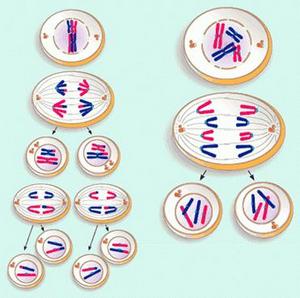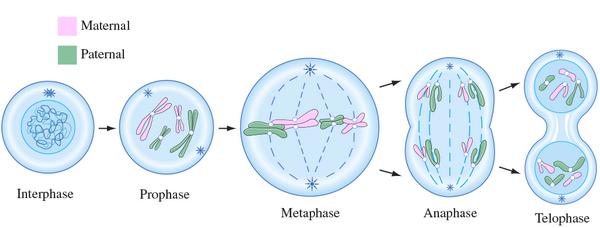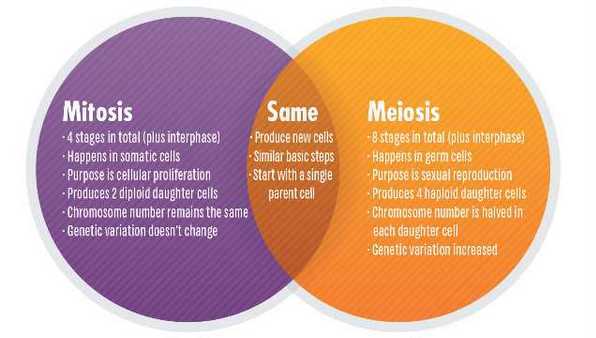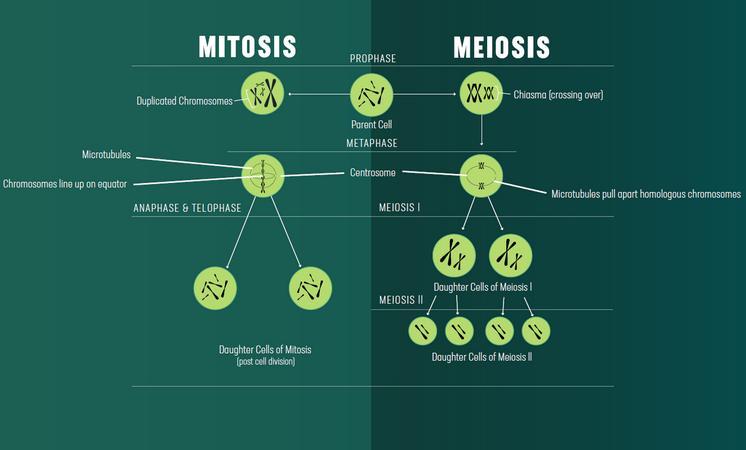Mitosis vs Meiosis: Differences and Similarities

Content:
There are many interesting and confusing topics in the multifaceted science of biology. One of them is the ways of cell division: mitosis and meiosis. At first look, there is a similarity between mitosis and meiosis – cell division occurs there and there, but at the same time there are significant differences between them. So, how is meiosis different from mitosis? In order to answer this question, first of all, let’s find out: what is mitosis and what is meiosis.
Mitosis Definition
Mitosis in biology is the most common way of dividing all the somatic cells (body cells) of any living creature. During mitosis two daughter cells are formed from the original mother cell. They are absolutely identical in properties, both with each other and with the mother cell. Mitosis is most common in Nature because it is the basis of the division of all non-sex cells (nerve, bone, muscle, etc.).
Stages of Mitosis
There are 4 stages of mitosis:
- Interphase – this is the period of cell life between two mitoses. A number of important processes occur during this stage: proteins and ATP molecules are synthesized, each chromosome doubles, forming two sister chromosomes that are held together by one centromere. Interphase can be called a preparatory stage for mitosis; it is ten times longer in time than mitosis itself.
- Profaza – chromosome thickening occurs in it, consisting of two sister chromatids, which are fastened together with a centromere. The nucleoli and the nuclear membrane disappear at the end of this stage. The chromosomes scatter throughout the cell.
- Metaphase – chromosome spiralization happens during this stage.
- Anaphase – centromere division occurs during this stage. Sister chromatids separate from each other and move to opposite ends of the cell.
- Telophase – this is the last stage of mitosis, division of the cytoplasm happens during this stage. Chromosomes unwind and re-form the nucleoli and nuclear membranes. Finally, from one cell arise two.

Meiosis Definition
What about meiosis? What is the difference between mitosis and meiosis? During meiosis four daughter cells are formed from the original mother cell. Yet the newly formed cells have only half the haploid set of chromosomes. What does this mean? According to some biologists, meiosis is not cell reproduction at all, since it is a way to form haploid cells, that is, a spores (in plants) and gametes (in animals). The gametes themselves will serve as the formation of a new organism only after fertilization, which in our case will be sexual reproduction.
You can see mitosis and meiosis differences and similarities at this picture.

Meiosis Stages
The meiosis phases are different from those of mitosis. Prophase in meiosis is many times longer since conjugation occurs in it – the connection of homologous chromosomes and the exchange of genetic information. Centromeres do not divide in anaphase. The interphase is very short and the DNA is not synthesized. Cells formed as a result of two meiotic сell divisions contain a single set of chromosomes. And only when two cells merge: maternal and paternal, diploidy is restored. Besides this, meiosis proceeds in two stages, known as meiosis І and meiosis ІІ.
A visual comparison of mitosis and meiosis and their stages can be seen in the picture.

What is the Purpose of Mitosis and Meiosis in Biology?
Now we will try to explain as simply as possible not only what the difference between mitosis and meiosis is, but also what is their biological significance. All non-sex cells of the body reproduce thanks to mitosis. The meiosis is just a way of forming germ cells, but only in animal organisms, in plants, due to meiotic division, spores multiply, and then from these spores, germ cells are formed by mitosis.
References and Further Reading
- Freeman, Scott (2011). Biological Science (6th ed.). Hoboken, NY: Pearson. p. 210.
- Letunic, I; Bork, P (2006). “Interactive Tree of Life”. Retrieved 23 July 2011.
- Bernstein H, Bernstein C, Michod RE (2011). “Meiosis as an evolutionary adaptation for DNA repair.” In “DNA Repair”, Intech Publ (Inna Kruman, editor), Chapter 19: 357-382 DOI: 10.5772/1751 ISBN 978-953-307-697-3 Available online from: http://www.intechopen.com/books/dna-repair/meiosis-as-an-evolutionary-adaptation-for-dna-repair
- Bernstein H, Bernstein C (2010). “Evolutionary origin of recombination during meiosis”. BioScience. 60 (7): 498–505. doi:10.1525/bio.2010.60.7.5.
- LODÉ T (2011). “Sex is not a solution for reproduction: the libertine bubble theory”. BioEssays. 33 (6): 419–422. doi:10.1002/bies.201000125. PMID 21472739.

Author: Pavlo Chaika, Editor-in-Chief of the journal Poznavayka
When writing this article, I tried to make it as interesting and useful as possible. I would be grateful for any feedback and constructive criticism in the form of comments to the article. You can also write your wish/question/suggestion to my mail pavelchaika1983@gmail.com or to Facebook.

